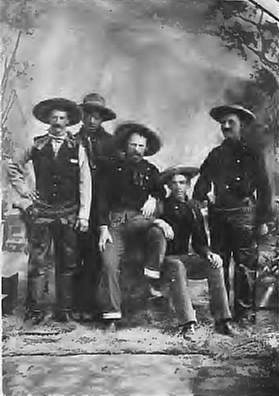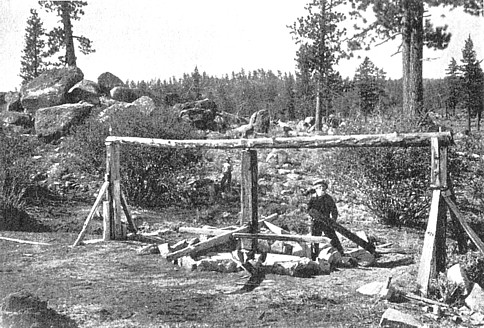Probably, the first white settler, if, indeed, a trapper at that time could be called a settler, was Pauline Weaver, a native of White County, Tennessee. Of his early history there is little known. His name is inscribed upon the walls of the Casa Grande with the date, 1833. He is credited with having explored the Verde, and also the Colorado River numerous times. There was hardly a foot of the Territory of Arizona he was not conversant with. Differing entirely from the majority of the trappers of that day, he had no difficulties with the Indians, but was always free to enter their camps. He had the confidence of the Pimas, the Maricopas, the Yumas, the Wallapais, the Mohaves and the different tribes along the Colorado, speaking their languages fluently. He was never known to engage in any hostile expedition against them, but was frequently a peace messenger, arranging, as far as possible, any difficulties between the whites and the Indians, without resorting to arms. He discovered the placers along the Gila, and also the placers at Weaver Diggings near Antelope Creek in the southern part of Yavapai County, a full account of which is given in one of the succeeding chapters of this volume. Weaver located a ranch in Yavapai County, where he lived for many years, and died at Camp Verde in the late 60 's and is buried in the Government burial ground.
In regard to Captain Pauline Weaver, very little was known about Captain Weaver. He had lived with the Yumas, Apache-Yumas, Mohaves, Apache-Mohaves and other tribes of Apaches since 1841. He was very uncommunicative and stoical; more Indian than white. I first met Weaver in 1864, at which time he was along in years. He soon after became a pensioner of the military and at Camp Verde was taken down sick, but strenuously opposed going into the hospital, declaring he could not live or breathe in a house. Before he took sick Weaver lived in a camp north of the post, perhaps a half mile or more away, and when found sick the commanding officer ordered a party of soldiers to take a tent and erect it over the sick man. Even this was objected to by the old man, but he was too sick to do more than object. Here he died and was buried by the military; and thus ended the career of this peculiar and mysterious character.
It was generally believed that Weaver had been an officer in the army at one time, but nothing of a certainty was ever known. One of the earliest groups to enter the central Arizona region came in response to the letters left with the Pimas, and consisted of what was known as the "Peeples' Party" This party was organized by A. H. Peeples in May, 1863, and entered Arizona from California, by way of Yuma, where they met Pauline Weaver, who had come by appointment, Peeples having written him from California. The party, with Weaver as guide, followed up the Colorado River to La Paz, where the Mexicans had been placer mining for some time.
They went east across the Plomosa Range and up the Cullen Valley. On nearing the mountains, some antelope were discovered, and Peeples followed them and succeeded in killing five. From this he named the stream Antelope Creek, and the mountain which rose from its northern bank, Antelope Peak. The party camped nearby, and before sundown had panned out some native gold, on what they named Weaver Creek, in honor of the guide. The next day, four Mexicans, who had joined the party at Yuma, started off after their horses which had strayed during the night. In the evening, they came in with their stock, and, taking Peeples aside, exhibited a large quantity of gold nuggets which they had picked up on top of the mountain (known later as “Rich Hill”). They could have kept the secret to them selves, but they gathered a large amount of gold and then rode safety into Mexico. The next morning, the party went to the top of the hill where innumerable chunks and nuggets of gold were found in a sort of sloping basin.
In about a month, all the surface gold was gathered and the party scattered, some remaining to work the gravel bars of Weaver Creek. It is estimated that during the first month a quarter of a million dollars in gold was gathered. The mountain was named Rich Hill, and has yielded many thousands of dollars since that time. Jack Swilling, it is said, was at the head of the party that discovered Rich Hill, near Weaver Creek, in the lower part of Yavapai County, in the year 1863. Be this as it may, Jack Swilling accumulated quite a fortune, either from these placers or others.
Late in 1862, or early in 1863, Pauline Weaver, who had crossed Arizona by the Gila as early as 1832, being attracted by the placers at La Paz, was induced to look for others in the interior of the country, and started with a party of men for an exploration. They discovered what has since been known as Weaver Diggings near Antelope Creek, and located the town of Weaver some sixty miles south of Prescott. About this time the Walker party of gold hunters arrived at the Pima Villages and determined to explore the country north, from which the Indians brought fabulous reports of great wealth. This party discovered the Hassayampa, one of the main streams of Central Arizona, having its rise about ten miles southeast of the town of Prescott, and running south until it sinks in the desert some twelve miles below the town of Wickenburg. Part of the Walker party went to the Weaver Diggings, and there Swilling and others, as we have seen, discovered the rich placers upon the top of Antelope Peak, which, from the accounts, was literally covered with gold, nuggets of unusual size being found. It is said that one man with his jack-knife took out four thousand dollars in a single day from these diggings, and that there was taken from the small area of ground a million dollars in gold.
The remainder of the Walker party gradually ascended the Hassayampa, finding gold at almost every point, and in the winter of 1863, took possession of the Lynx Creek and Walker Diggings, ten miles east from Prescott, from which it was estimated that not less than half a million of dollars was taken. They also gathered much gold on Big Bug, four miles east of Lynx Creek, and when these placers were exhausted, the prospectors turned their attention to quartz veins, and found there was no lack of them all along the Hassayampa, and upon the Agua Fria, a parallel stream of considerable size, and also upon Lynx Creek, Big Bug, and Turkey Creek, and other creeks in Central Arizona, lodes of gold ore, silver and copper were found. In the excitement, as is always the case, a great many locations were made and recorded which had no value. Of course the Hassayampa is famous for the local legend that purports that anyone who drinks from the river can never again tell the truth, save a dollar or leave Arizona.
Return
to The Arizona Page:
Arizona Gold Rush Mining History



